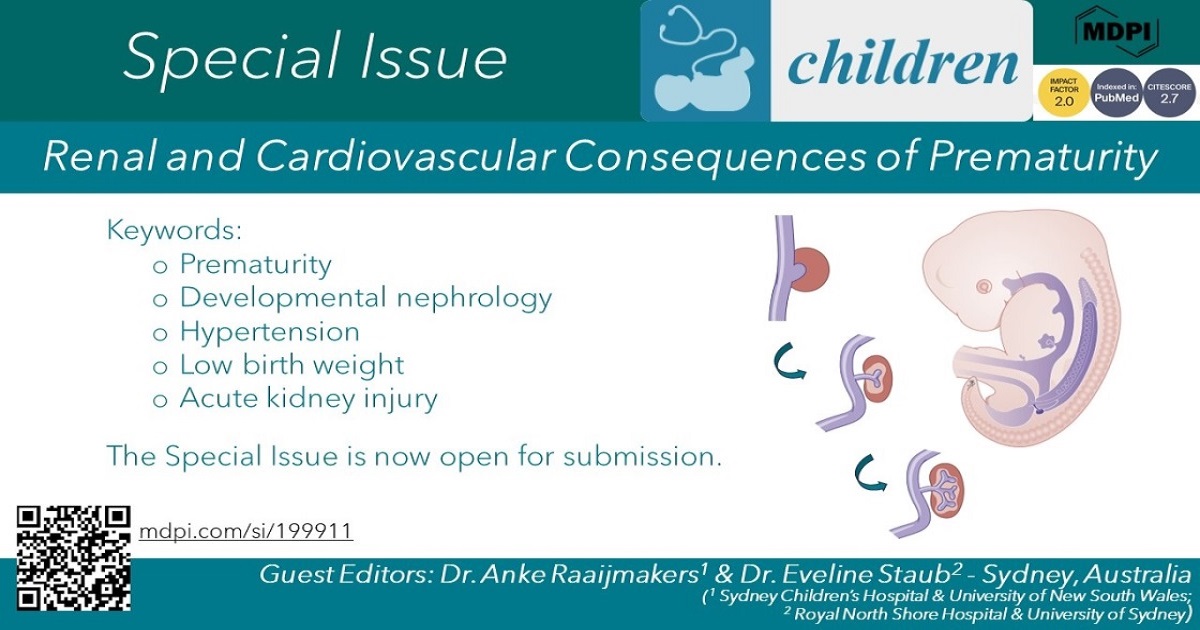Renal and Cardiovascular Consequences of Prematurity
A special issue of Children (ISSN 2227-9067). This special issue belongs to the section "Global Pediatric Health".
Deadline for manuscript submissions: closed (20 April 2025) | Viewed by 17127

Special Issue Editors
2. School of Women's and Children's Health, University of New South Wales, Randwick Clinical Campus, Randwick, NSW 2031, Australia
Interests: prematurity; cardiovascular disease in childhood; hypertension; developmental nephrology
2. University of Sydney Northern Clinical School, Royal North Shore Hospital, St Leonards, NSW, Australia
Interests: prematurity; cardiovascular disease in childhood; hypertension; developmental nephrology
Special Issue Information
Dear Colleagues,
Through this Special Issue, we would like to increase awareness regarding the long-term cardiovascular consequences of preterm birth.
Acceptable articles for this Special Issue include original research articles or reviews related to this topic. Neonatologists sharing their knowledge on the early prevention of kidney injury is also welcome. Avoiding hit after hit for the cardiovascular system and the kidneys would be an excellent prevention strategy that we look forward to highlighting.
Dr. Anke Raaijmakers
Dr. Eveline Staub
Guest Editors
Manuscript Submission Information
Manuscripts should be submitted online at www.mdpi.com by registering and logging in to this website. Once you are registered, click here to go to the submission form. Manuscripts can be submitted until the deadline. All submissions that pass pre-check are peer-reviewed. Accepted papers will be published continuously in the journal (as soon as accepted) and will be listed together on the special issue website. Research articles, review articles as well as short communications are invited. For planned papers, a title and short abstract (about 250 words) can be sent to the Editorial Office for assessment.
Submitted manuscripts should not have been published previously, nor be under consideration for publication elsewhere (except conference proceedings papers). All manuscripts are thoroughly refereed through a single-blind peer-review process. A guide for authors and other relevant information for submission of manuscripts is available on the Instructions for Authors page. Children is an international peer-reviewed open access monthly journal published by MDPI.
Please visit the Instructions for Authors page before submitting a manuscript. The Article Processing Charge (APC) for publication in this open access journal is 2400 CHF (Swiss Francs). Submitted papers should be well formatted and use good English. Authors may use MDPI's English editing service prior to publication or during author revisions.
Keywords
- prematurity
- hypertension
- low birth weight
- developmental nephrology
Benefits of Publishing in a Special Issue
- Ease of navigation: Grouping papers by topic helps scholars navigate broad scope journals more efficiently.
- Greater discoverability: Special Issues support the reach and impact of scientific research. Articles in Special Issues are more discoverable and cited more frequently.
- Expansion of research network: Special Issues facilitate connections among authors, fostering scientific collaborations.
- External promotion: Articles in Special Issues are often promoted through the journal's social media, increasing their visibility.
- Reprint: MDPI Books provides the opportunity to republish successful Special Issues in book format, both online and in print.
Further information on MDPI's Special Issue policies can be found here.







